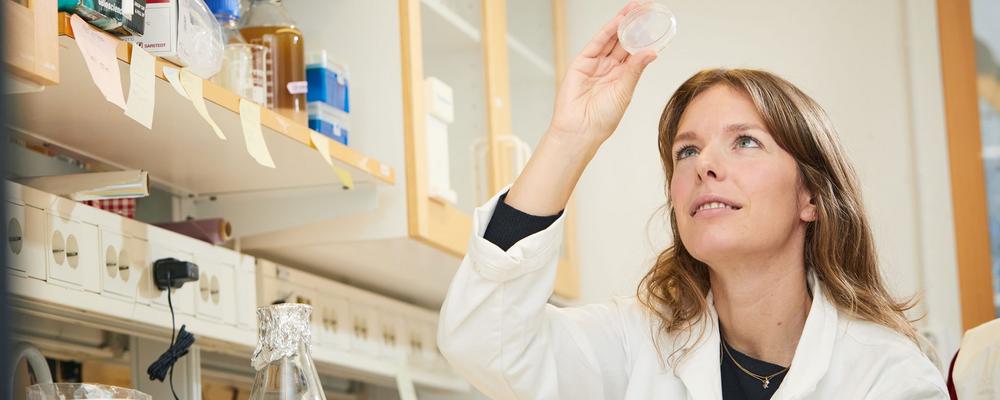Lekholm leads the way to the lab where she is studying the tiny nematode, C. elegans. She bends over the microscope to adjust the focus on the agar plate. Once in focus, the millimetre-long worm is clearly visible, even though it is transparent. This worm is easy to genetically manipulate in various ways, such as being turned into fluorescent green. Through various experiments, she is investigating how the signalling in the worm’s nervous system works and how these signals affect their behaviour. For this purpose, C. elegans is the perfect animal model.
How did you become a researcher?
“As early as my childhood in Falköping, I did everything I could to find a summer job in a lab. So I worked at a dairy where I tested their products, looked at bacterial cultures and cultured milk to ensure that there were no dangerous bacteria in it. Or that the farmers had used antibiotics against the rules. But we also did taste tests of the milk. It was quite disgusting and today, I prefer to avoid drinking milk.
“I’ve always been interested in chemistry and biology, and first applied to become a biomedical analyst, but after a year, switched to the Master of Science in Pharmacy Programme.”
What kind of research have you conducted?
“As a doctoral student, I studied how the behaviour of rats was changed by nicotine, even after a long break. The thesis received a lot of media attention, even internationally. But during my postdoc, I switched to studying the nematode C. elegans to investigate how information transfer between neurons, which takes place via ion channels, works at the molecular level.
“Unlike in humans, C. elegans has only 302 trillion nerve cells, which makes it much easier to track how the signals are propagated in the nervous system. Furthermore, we can genetically manipulate these worms quite easily using various methods such as CRISPR/Cas 9, which was awarded the Nobel Prize in 2020.”
How did your career in research begin?
“I did my MSc degree project in New York with Eric Kandel, who was awarded the Nobel Prize together with Arvid Carlsson in 2000. Eric is a professor at Columbia University in New York. It turned out to be a very long degree project, and I was in his lab for more than a year. It was incredibly inspiring and fun! I also had the opportunity to publish jointly with a Nobel laureate while still at Master’s level, which helped me in the beginning of my career.
“I would have preferred to stay on and complete my PhD at Columbia University, but the bureaucracy is very difficult to deal with when you don’t have a US degree, so I applied for a doctoral programme at the Department of Clinical Neuroscience and Physiology at the University of Gothenburg’s Sahlgrenska Academy. When I was finished, my husband, who is also a researcher, and I went to the city of Cambridge in the UK with our then two-year-old son.
“I had just received a SEK 3 million post-doctoral grant from the Swedish Research Council, which followed me to my new workplace – the MRC Laboratory of Molecular Biology. It is a state-funded research institute that has functioned as a nursery for many Nobel laureates. Two Nobel Prizes were awarded during my time at the institute. My husband and I rented a classic terrace house with a narrow garden. Those were fun and educational years, with a lot of work!”
What does your research mean for society?
“We don’t actually know what the normal functions of a nervous system look like, and how they change over time, or in different normal states. We know a bit, but have only just scratched the surface, and through my studies of the C. elegans nematode, I hope we can learn a little more about the fundamental principles that govern our nervous systems.
ABOUT JULIA MORUD LEKHOLM
Age: 38
Role: Researcher in molecular biology and biochemistry.
Best researcher qualities: Inquisitive, persevering and thorough.
Family: Husband, who is a professor of biomedicine, and a seven-year-old son.
Hobbies and interests: Horseback riding, gardening and knitting.
